Here again Tim Burton's imagination is the limit. The visuals are stunning, the story is funny and never gets boring, and it's tough to make up your mind whether Willy Wonka is actually a guy or a girl. As with anime films, directors have finally realized that they shouldn't make movies just for kids. They try to appeal now in a adult audience, since the kids watch the movie anyways.
Friday, July 29, 2005
Charlie and the Chocolate Factory * * *
Here again Tim Burton's imagination is the limit. The visuals are stunning, the story is funny and never gets boring, and it's tough to make up your mind whether Willy Wonka is actually a guy or a girl. As with anime films, directors have finally realized that they shouldn't make movies just for kids. They try to appeal now in a adult audience, since the kids watch the movie anyways.
Another Aspect of reality - part 2
Bell's inequalities are infinite in number since they depend on the experimental setup and the type of questions we ask about the system. Here is the version that I am going to use:
Probability of getting the same color from both detectors >= 5/9
So I will setup an experiment for which the above inequality makes sense. I will prove that using common sense and locality, the inequality is satisfied. Then I will use some simple Quantum Mechanics and defy locality to prove that the inequality is violated (in fact I will prove the probability to be 1/2). And I will do that using only high school math.
In 1983 Aspect did the corresponding experiment and found that the inequality is indeed violated, confirming that QM is a non local theory (i.e. there are no hidden variables and there is an instant communication between 2 photons).
Rules:
1. We have a source that emits a pair of 2 identical photons. Each pair may have different properties, but the photons inside each pair are identical. Each photons heads towards a different detector.
2. We have 2 detectors that can flash either red or green, depending on the polarization (direction) of the photons.
3. Each detector can be aligned randomly along one of 3 predetermined axes of polarization. Let's assume for example that these axes are at 120 degrees angle with eachother. We name these positions 1, 2 and 3. Each detector can be set independent from the other.
4a. The photon source emits 2 types of pairs of photons, type I and type II. We cannot know which type of pair is emitted at each take of the experiment.
4b. Type I pairs of photons always cause both detectors two flash green (for example, the photons can have polarization that is never opposite to any of the 3 main axes - they will always contain some component in any of the 3 axes; hence it doesn't matter how the detectors are aligned, they will always both flash green). The probability of the detectors flashing the same color is 1.
4c. Type II pairs of photons cause the detectors to flash green only when the detector is oriented at position 2 (the polarization of the photon is along that direction). Then each detector will flash green exactly 1/3 of the time. What is the probability that both detectors will flash the same color? You can prove simply that this is 5/9:

So, whenever any detector is set at position 2 and the other one isn't then they flash a different color (D) ; in any other case they flash the same (S). Take some time to convince yourselves for that since this is the whole proof!
Now, Bell's inequality comes as an answer to the question: What is the probability of getting the same color from both detectors? Answer: the probability is always equal or greater than 5/9. In our case this probability is either 5/9 (if type II photons are emitted) or 1 (if type I photons are emitted).
Probability of getting the same color from both detectors >= 5/9
This is the common sense answer and it seems like there can be nothing else other than that. That is because you implicitly assume that the property of each pair of photons (whether it is type I or II) is pre-determined at the birth of the photons. However in the next part I will prove that QM allows for the probability to be 1/2, which means that the determination of the type happens exactly when the detector flashes, and not beforehand!
To be continued...
Probability of getting the same color from both detectors >= 5/9
So I will setup an experiment for which the above inequality makes sense. I will prove that using common sense and locality, the inequality is satisfied. Then I will use some simple Quantum Mechanics and defy locality to prove that the inequality is violated (in fact I will prove the probability to be 1/2). And I will do that using only high school math.
In 1983 Aspect did the corresponding experiment and found that the inequality is indeed violated, confirming that QM is a non local theory (i.e. there are no hidden variables and there is an instant communication between 2 photons).
Rules:
1. We have a source that emits a pair of 2 identical photons. Each pair may have different properties, but the photons inside each pair are identical. Each photons heads towards a different detector.
2. We have 2 detectors that can flash either red or green, depending on the polarization (direction) of the photons.
3. Each detector can be aligned randomly along one of 3 predetermined axes of polarization. Let's assume for example that these axes are at 120 degrees angle with eachother. We name these positions 1, 2 and 3. Each detector can be set independent from the other.
4a. The photon source emits 2 types of pairs of photons, type I and type II. We cannot know which type of pair is emitted at each take of the experiment.
4b. Type I pairs of photons always cause both detectors two flash green (for example, the photons can have polarization that is never opposite to any of the 3 main axes - they will always contain some component in any of the 3 axes; hence it doesn't matter how the detectors are aligned, they will always both flash green). The probability of the detectors flashing the same color is 1.
4c. Type II pairs of photons cause the detectors to flash green only when the detector is oriented at position 2 (the polarization of the photon is along that direction). Then each detector will flash green exactly 1/3 of the time. What is the probability that both detectors will flash the same color? You can prove simply that this is 5/9:

So, whenever any detector is set at position 2 and the other one isn't then they flash a different color (D) ; in any other case they flash the same (S). Take some time to convince yourselves for that since this is the whole proof!
Now, Bell's inequality comes as an answer to the question: What is the probability of getting the same color from both detectors? Answer: the probability is always equal or greater than 5/9. In our case this probability is either 5/9 (if type II photons are emitted) or 1 (if type I photons are emitted).
Probability of getting the same color from both detectors >= 5/9
This is the common sense answer and it seems like there can be nothing else other than that. That is because you implicitly assume that the property of each pair of photons (whether it is type I or II) is pre-determined at the birth of the photons. However in the next part I will prove that QM allows for the probability to be 1/2, which means that the determination of the type happens exactly when the detector flashes, and not beforehand!
To be continued...
Wednesday, July 27, 2005
The Hot Chick * *

Rachel McAdams is just great. After watching this movie I have watched every major movie of hers (The Notebook, Mean Girls, The Hot Chick, Wedding Crashers) and Red Eye is coming up on August 19th.
This movie was terribly done, feels awkward from time to time, yet it has some of the most hilarious moments I've seen in recent comedies where the laughs just come out naturally.
Another Aspect of reality
After thousands of requests I got from my readers around the world (sic) I will try to explain one of the darkest corners of Quantum Mechanics: The EPR paradox, Bell's inequalities, the Aspect experiment, reality and locality in Quantum Mechanics.
The story consists of 2 parts. First, the original EPR paradox stated by Einstein, Podolsky and Rosen in 1935, where they argued that QM is not complete as a theory. Second, Bell formulated some inequalities that relate to the paradox and they can be experimentally tested. Aspect in 1983 performed the experiment and proved that Einstein was wrong, and that Bell's inequality is violated.
Usually people when they try to explain physics they come up with a real world example, an analogy, that non-scientists can grasp in order to make themselves understood. Although I do not completely agree with the approach, since it reduces the complexity by taking away critical facts, I will use an example here which is OK as long as one realizes the restrictions that apply.
In their paper they proposed a thought experiment that goes something like that. Imagine you and a friend are magically given each a piece of paper and that each paper has inscribed a positive integer on it, and you are told that the numbers on each paper is random, under the condition that their product is always 24. Then you drive to the east coast and your friend drives to the west coast. When you read the paper, say the number 12, you instantly know that the number written in the other paper is 2. Similarly, if you repeat the experiment and you finally read 6, you instantly know that your friend's paper reads 4, etc.
The point here is to realize that the 2 properties (the numbers) are random yet they have to satisfy some combining condition that you know ahead of time. This is ok as long as the numbers are predetermined and written on the papers beforehand. However, the problem arises because Quantum Mechanics says that the number you read is determined at the exact moment you read the paper (i.e, after you travel to the east coast). Hence at the same moment the other number on the other coast is determined afterwards and at the same time you conduct your experiment, i.e. when you read the paper. This means that a faster than light signal (forbidden by relativity) is somehow transmitted from one side to the other. This is the EPR paradox.
In their paper they attempted to resolve the paradox by introducing the so called hidden variables; that despite what QM says, there are some hidden variables that pre-determine the value of the numbers at their origin point. Bell later on he derived an inequality that expresses exactly this fact. And Aspect proved that it was all wrong.
Here we must distinguish between causality and locality. Causality means that something is happening before its cause (e.g. faster than light speed); locality means that there is a "spooky action at a distance" that allows something to be affected instantly by something on the other side of the universe. The experiment proved that Quantum Mechanics violates locality but not causality.
In reality instead of numbers in pieces of paper people use photons with polarizations (the direction that the vector is pointing). What they do is they generate e.g. photons that must have opposite polarizations, so if one is up the other has to be down and vice versa. However the initial state of the photon is random, it can be either. And EPR say the state is determined in the birth of the photons, while QM says it is determined at the instant of observation of either photon.
So, it remains to be seen how the experiment proved how QM was right after all.
To be continued...
The story consists of 2 parts. First, the original EPR paradox stated by Einstein, Podolsky and Rosen in 1935, where they argued that QM is not complete as a theory. Second, Bell formulated some inequalities that relate to the paradox and they can be experimentally tested. Aspect in 1983 performed the experiment and proved that Einstein was wrong, and that Bell's inequality is violated.
Usually people when they try to explain physics they come up with a real world example, an analogy, that non-scientists can grasp in order to make themselves understood. Although I do not completely agree with the approach, since it reduces the complexity by taking away critical facts, I will use an example here which is OK as long as one realizes the restrictions that apply.
In their paper they proposed a thought experiment that goes something like that. Imagine you and a friend are magically given each a piece of paper and that each paper has inscribed a positive integer on it, and you are told that the numbers on each paper is random, under the condition that their product is always 24. Then you drive to the east coast and your friend drives to the west coast. When you read the paper, say the number 12, you instantly know that the number written in the other paper is 2. Similarly, if you repeat the experiment and you finally read 6, you instantly know that your friend's paper reads 4, etc.
The point here is to realize that the 2 properties (the numbers) are random yet they have to satisfy some combining condition that you know ahead of time. This is ok as long as the numbers are predetermined and written on the papers beforehand. However, the problem arises because Quantum Mechanics says that the number you read is determined at the exact moment you read the paper (i.e, after you travel to the east coast). Hence at the same moment the other number on the other coast is determined afterwards and at the same time you conduct your experiment, i.e. when you read the paper. This means that a faster than light signal (forbidden by relativity) is somehow transmitted from one side to the other. This is the EPR paradox.
In their paper they attempted to resolve the paradox by introducing the so called hidden variables; that despite what QM says, there are some hidden variables that pre-determine the value of the numbers at their origin point. Bell later on he derived an inequality that expresses exactly this fact. And Aspect proved that it was all wrong.
Here we must distinguish between causality and locality. Causality means that something is happening before its cause (e.g. faster than light speed); locality means that there is a "spooky action at a distance" that allows something to be affected instantly by something on the other side of the universe. The experiment proved that Quantum Mechanics violates locality but not causality.
In reality instead of numbers in pieces of paper people use photons with polarizations (the direction that the vector is pointing). What they do is they generate e.g. photons that must have opposite polarizations, so if one is up the other has to be down and vice versa. However the initial state of the photon is random, it can be either. And EPR say the state is determined in the birth of the photons, while QM says it is determined at the instant of observation of either photon.
So, it remains to be seen how the experiment proved how QM was right after all.
To be continued...
Tuesday, July 26, 2005
The Island * * *

Michael Bay is one of my favorite directors. After being tired of doing Bruckheimer army movies, he has started trying other things: Thriller, in the Texas Chainsaw Massacre. Sci-Fi, in The Island. And the new Transformers movie is coming in next.
The movie is good and great fun, never lets you bored, yet it's not anything memorable. Scarlett Johansson never looked any better than this, and the sight of 2090 LA is so much fun. I like how they created a world not-so-different from 2005, which I think is more realistic. Their biggest flaw is that they let too much of the story to the public before the release of the movie.
Dark Water *
I had forgotten how a bad movie in the theatre looks like... While Jennifer Connely is very good as always, the story doesn't make much sense and it's not that scary either. Yet, as Roeper said, this is the first time in the movies that the characters live in an apartment that corresponds to their actual economic status (don't even start to mention Friends!).
Monday, July 25, 2005
Keep merging
This is very useful: following this link you can find google earth traffic maps that superimpose sigalert's traffic conditions over the maps of google.
Thursday, July 21, 2005
Noise free at last!
That simulation that was running while I was in Vegas was as good as the time I had there. After reducing the simulation from 2D to 1D and pushing into ultra high resolution, the deviation between the simulation and my theory is now less than 10%. This agreement is astonishing for these kind of simulations that involve millions of particles in a complicated structure. On top of that the result is clean, noise-free and as smooth as Laetitia's curves.
I will now proceed to simulate the full length of our run, which is 3 times longer (I had to simulate shorter lengths because until now the noise was growing fast).
I will now proceed to simulate the full length of our run, which is 3 times longer (I had to simulate shorter lengths because until now the noise was growing fast).
Tuesday, July 19, 2005
My biggest simulation yet
I just submitted the most important simulation I've prepared so far. It will run parallel in 32 dual Xeon processors at USC's Hyper Performance Computer Cluster. It will need about 15 hours to complete, which is a ridiculus number for a 1D simulation. The reason it takes so long is that I need hyper-fine resolution on my parameters, since all the details have to be captured and also it has to be resilient to numerical noise (the situation improves the higher the resolution since nearby points are closer together hence the transition between them is smoother).
If my calculations are correct, the simulation will be done by the time I get back from Vegas. Viva!
If my calculations are correct, the simulation will be done by the time I get back from Vegas. Viva!
LA Confidential
That movie is genious... thet plot and the way it unfolds is masterfully done, so I think this is one of the most complicated stories I've ever seen on film. Plus, it has Los Angeles written all over it! Guy Pearce is underated since he has incredible potential as an actor (Just watch him in my all-time-favorite Memento. I still cannot grasp the whole plot in that movie).
Monday, July 18, 2005
Extraterrestrial activity on earth
Anyone who pictures scientists as calm and reserved should have seen us when the data from the gamma-ray flash appeared in our computer. One might have thought that our favorite team had just scored the winning touchdown at the superbowl.
That was one of the best articles in Scientific American I've ever read. The topic is lightning. As it turns out, we know almost nothing regarding how lightning works! Of course, Benjamin Franklin proved 250 years ago that it is an electric effect, with electrons accumulating in the clouds and a current (spark) produced with the positive ions in the surface.
However, none knows how the charge gets there in the first place. On top of that, all the measurements of storms show that the electric field inside the clouds is 10 times smaller than the electric field that causes the small spark after we walk on a carpet and then touch some metal item. How then can the lightning form in the first place?
The incident described at the beginning of the thread occurred when they discovered that lightnings produce gamma-rays and x-rays, which proved that an effect called runaway breakdown occurs. What probably happens is that high energy cosmic rays from outer space hit some air molecule (oxygen, nitrogen) and cause an electron to be removed (yes, the origin of the lightning is extraterrestrial!). The high speed electron causes an avalanche, as it keeps bouncing on more and more molecules and more and more electrons accumulate, while producing gamma-rays.. These electrons are accelerated even more to speeds close to the speed of light from the local electric fields inside the clouds. This is the catalyst of lightning.
Once the lightning has initiated, the first electrons start heading downwards. They follow a bumpy left-right discrete step motion as they collide with air molecules, ionizing them, produce x-rays while changing direction. Eventually these first leader electrons reach the ground.
Once this ionized channel has formed, a large current (more electrons!) flows through the channel to the ground. These electrons move so fast that 1) heat up the air, producing the visible part of the lightning and 2) the heat compresses and decompresses the air violently, causing the audible part, the thunder.
That was one of the best articles in Scientific American I've ever read. The topic is lightning. As it turns out, we know almost nothing regarding how lightning works! Of course, Benjamin Franklin proved 250 years ago that it is an electric effect, with electrons accumulating in the clouds and a current (spark) produced with the positive ions in the surface.
However, none knows how the charge gets there in the first place. On top of that, all the measurements of storms show that the electric field inside the clouds is 10 times smaller than the electric field that causes the small spark after we walk on a carpet and then touch some metal item. How then can the lightning form in the first place?
The incident described at the beginning of the thread occurred when they discovered that lightnings produce gamma-rays and x-rays, which proved that an effect called runaway breakdown occurs. What probably happens is that high energy cosmic rays from outer space hit some air molecule (oxygen, nitrogen) and cause an electron to be removed (yes, the origin of the lightning is extraterrestrial!). The high speed electron causes an avalanche, as it keeps bouncing on more and more molecules and more and more electrons accumulate, while producing gamma-rays.. These electrons are accelerated even more to speeds close to the speed of light from the local electric fields inside the clouds. This is the catalyst of lightning.
Once the lightning has initiated, the first electrons start heading downwards. They follow a bumpy left-right discrete step motion as they collide with air molecules, ionizing them, produce x-rays while changing direction. Eventually these first leader electrons reach the ground.
Once this ionized channel has formed, a large current (more electrons!) flows through the channel to the ground. These electrons move so fast that 1) heat up the air, producing the visible part of the lightning and 2) the heat compresses and decompresses the air violently, causing the audible part, the thunder.
Envelopes
I have a differential equation that describes a specific nonlinear oscillation. I don't care about the exact shape, but I do care about the envelope of the solution. I care about the maxima, the minima and the zero crossings. The question is, can I find the envelope of a function that is a solution to such a differential equation without actually knowing the function itself explicitly?
Sunday, July 17, 2005
Quantum Black Holes
An very interesting article in one of the recent Scientific American: Essentially what they are saying is that the LHC, the new particle accelerator/collider that will start operating in 2007, will smash protons so hard together that their mass and energy is so great that tiny black holes may form.
Here is the trick though: in a conventional world with 4 dimensions gravity is not strong enough to create the black holes. However if String Theory is correct and the world has 11 dimensions, then the gravity is much stronger at he tiny level and it should be enough to create the Black Holes.
The Black Holes will be so small that they vaporize fast and as they do they emit radiation and particles. Several groups around the world have already published predictions on how the detectors will look like and what kind of data we should see.
Hence in a couple of years we may already have the first evidence that we live in a higher-dimensional world; the sheer potential of this happening is just overwhelming...
Here is the trick though: in a conventional world with 4 dimensions gravity is not strong enough to create the black holes. However if String Theory is correct and the world has 11 dimensions, then the gravity is much stronger at he tiny level and it should be enough to create the Black Holes.
The Black Holes will be so small that they vaporize fast and as they do they emit radiation and particles. Several groups around the world have already published predictions on how the detectors will look like and what kind of data we should see.
Hence in a couple of years we may already have the first evidence that we live in a higher-dimensional world; the sheer potential of this happening is just overwhelming...
Wedding Crashers
1. This movie was far better than I expected.
2. The wedding crasher theme is just for the first 20 minutes - it gets independent after that, and then the fun starts!
3. The dinner scene was simply one of the best scenes I've seen in any comedy - me and everyone else in the theatre were laughing so hard that after some point I couldn't listen to what they were saying.
4. Ther 2nd half of the movie is very trivial, but that's the case with all of these movies.
4. Rachel McAdams does not look very exciting in pictures, but on the big screen she is simply s-t-u-n-n-i-n-g . She just fills the screen whenever she appears. If I had to pick one the most promising young actress she is my pick. If she makes the right choices the Oscar won't be far away.
2. The wedding crasher theme is just for the first 20 minutes - it gets independent after that, and then the fun starts!
3. The dinner scene was simply one of the best scenes I've seen in any comedy - me and everyone else in the theatre were laughing so hard that after some point I couldn't listen to what they were saying.
4. Ther 2nd half of the movie is very trivial, but that's the case with all of these movies.
4. Rachel McAdams does not look very exciting in pictures, but on the big screen she is simply s-t-u-n-n-i-n-g . She just fills the screen whenever she appears. If I had to pick one the most promising young actress she is my pick. If she makes the right choices the Oscar won't be far away.
Saturday, July 16, 2005
Harry Potter vs Halo 2
A few moments ago the most recent Harry Potter book has released. 10.8 million copies were made for the first print, when the first book of the series had only 50,000 first prints. They say that it will surpass Halo 2 as the most succesful entertainment item for any single day. Halo 2 had sales of $125,000,000 the first day of its release, which is the most money any film, dvd, cd or book ever made on any day.
We will all know in 24hours...
We will all know in 24hours...
Friday, July 15, 2005
War of the Worlds

Independently of whether or not you like the movie, one has to agree that Spielberg has not made bad movies. Every one of his movies is at least fun to watch, and then there are of course statistical variations on the likability. The sure thing about War of the Worlds is that Spielberg has done a magnificent job in filmmaking - some of the scenes are filmed extremely well.
My favorite one is when Tom Cruz is driving their van with his son and his daughter inside away from their home, and they argue as to what is happening and what to do next. The camera starts filming from the front, as Cruz argues about his actions. Slowly and steadily the camera moves to the side, filming from the left hand side of the van. While still discussing, and as Dacota Fanning enters the conversation the camera continuously enters from the open rear left window, now looking towards the front of the van from the inside. Without stopping, the camera travels across the back seats, exits from the open rear right window, while the family is still arguing. Then it moves to the left hand side, and as Cruz takes control as the main negotiator of the conversation again, the camera has gradually moved to the outside front of the van and focuses on him, completing a loop of camera motion and discussion.
This scene was pure joy to watch. It is now one of my favorite scenes in any movie.
Thursday, July 14, 2005
Pink Panty Poker
2009 for HDTV cutoff
If something like that happened in Greece, there would be protests and people complaining in the papers and in the tv channels. However US is such a huge melting pot of people that there can never be a strong unified voice pro or against such decisions. Eventually everyone will switch, willing or not. Who said about fairness?
Monday, July 11, 2005
Mr Amazon
Amazon.com has a 10 year anniversary, and I decided to stop for a while and count my purchases from Amazon. Ever since I came to the US I've had 47 orders from Amazon in the last 2 years (that's twice a month on average). Right now they have 50 million active customers and $6 billion per year in sales, which means that the average customer spends $120 a year on Amazon products. eBay transactions add up to $40 billion or so, but that is merely redistributing of items and not selling, which makes Amazon the most successful e-store ever.
Saturday, July 09, 2005
Greek memoirs
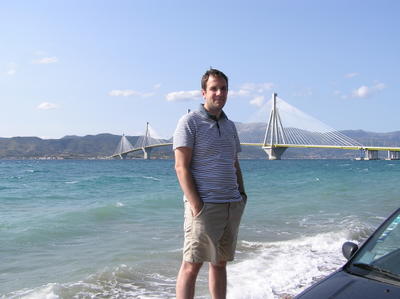 I had to end the crab bloggging with just a couple pictures of greece. Above is the Rio bridge, the longest hanging bridge in the world. If you look closer you'll see tha the road does not sit on top of the blocks; rather, the whole structure is hanging as if from ropes from the 4 towers, and their base is bigger than a footlball stadium in cement.
I had to end the crab bloggging with just a couple pictures of greece. Above is the Rio bridge, the longest hanging bridge in the world. If you look closer you'll see tha the road does not sit on top of the blocks; rather, the whole structure is hanging as if from ropes from the 4 towers, and their base is bigger than a footlball stadium in cement. Same view, but in the night. The bridge can be seen from dozens of miles away as it is comparable to the nearby mountains.
Same view, but in the night. The bridge can be seen from dozens of miles away as it is comparable to the nearby mountains. And that's a sunset outside our beach house.
And that's a sunset outside our beach house.
Niagara Falls

We had a far better time at the Falls than what I expected. I just couldn't imagine the size and volume of the water that they contain. In the above picture the falls on the left consist only 10% of the total volume of water. The rest falls in the back, the Horseshoe falls.
 Nicola Tesla was working at Cornell, and he built the first ever hydroelectric plant that can still be seen today at the edge of the Horseshoe falls.
Nicola Tesla was working at Cornell, and he built the first ever hydroelectric plant that can still be seen today at the edge of the Horseshoe falls. 3 things excited me most: First, the boat trip close enough to the base of the Horseshoe Falls. Suddenly we were being surrounded by millions of gallons of water falling all around us - it was impossible not to whisper wow.
3 things excited me most: First, the boat trip close enough to the base of the Horseshoe Falls. Suddenly we were being surrounded by millions of gallons of water falling all around us - it was impossible not to whisper wow. Part #2: The walk close to the edge of a side-fall of the smaller American Falls. Next time I'm bringing my swimsuit there.
Part #2: The walk close to the edge of a side-fall of the smaller American Falls. Next time I'm bringing my swimsuit there.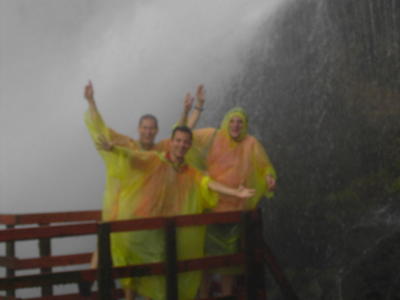 We tried to get a nice picture there but the mist of the water didn't allow the camera to focus properly. The water hitting us is about 1/1000 of the total water of the Niagara Falls, since the 10% of the 10% is falling at that fall, and we are being hit by water bounced off a rock, so that's another 10% there.
We tried to get a nice picture there but the mist of the water didn't allow the camera to focus properly. The water hitting us is about 1/1000 of the total water of the Niagara Falls, since the 10% of the 10% is falling at that fall, and we are being hit by water bounced off a rock, so that's another 10% there. The Englishman and me had the most fun - this is right after the wet portion of the trip.
The Englishman and me had the most fun - this is right after the wet portion of the trip. unfortunately no picture or words can capture the beauty of the falls in the night lights. It is truly one of the most spectacular images anywhere on earth. Next time I'm visiting the falls from the Canadian side, since the falls are essentially on the American side hence you need to be opposite in Canada to see them. A small Las Vegas has developed there over the past few years, and the place keeps increasing in popularity since the young brother of Napoleon went there for his honeymoon almost 200 years ago.
unfortunately no picture or words can capture the beauty of the falls in the night lights. It is truly one of the most spectacular images anywhere on earth. Next time I'm visiting the falls from the Canadian side, since the falls are essentially on the American side hence you need to be opposite in Canada to see them. A small Las Vegas has developed there over the past few years, and the place keeps increasing in popularity since the young brother of Napoleon went there for his honeymoon almost 200 years ago.
Friday, July 08, 2005
Summer School Everyday Moments
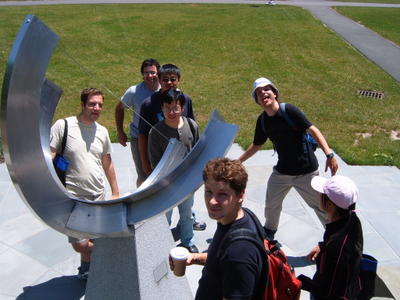 For some reason we thought it would be cool to take a picture in front of a solar clock... And for some reason it feels very good.
For some reason we thought it would be cool to take a picture in front of a solar clock... And for some reason it feels very good.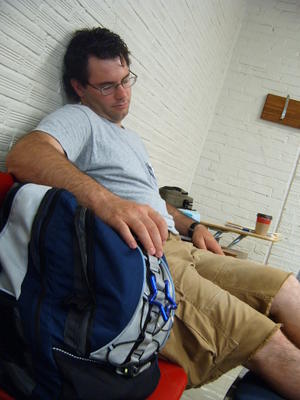
The class was very interesting and we could barely focus on anything else other than the material on the blackboard.
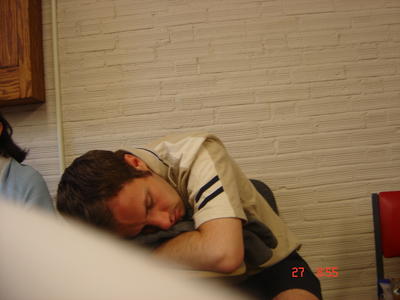
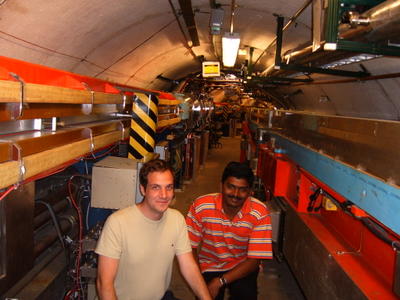 Same here... I'm so excited.
Same here... I'm so excited.Cornell has amazing facilities, escpecially for particle physics. They host CESR, a mile-long circular accelerator that could easily be a goverment lab on its own (yet the students get their own time there!). We were lucky to visit them on their maintenace day so we could actually go inside the tunnel and observe the ring from close up.

A typical evening in the dining room... After the dinner, the dishes are replaced with notebooks and the glasses with calculators and book. All trying to tackle Mr Waldo's problems.
Diktys and I, a who just read and started working on the final exam.
And something you won't see in Greece...
20 degrees
After thousands of years of human history, science has finally found the answer to the eternal question on how should one throw a small stone in a lake/sea such that it will bounce the most times. In an article published in Nature about a year ago the experimental data showed that the optimum throwing angle is 20 degrees with respect to the surface. And a couple of weeks ago in an article published in Physical Review Letters a group studied theoretically the event and found out that the answer is indeed around 20 degrees.
Now I can rest in peace.
Now I can rest in peace.
New York on Holiday
The only full day we spent in NYC was the Saturday at the 4th of July weekend. Most people have left for holidays, yet the parks and amusement places were packed with people. I again felt what I call "New York feeling", that the city and its people just feel different in a way that is impossible for me to describe. You just have to be there.
 As I was walking in front of the public library in the morning on our way to the subway, I noticed a familiar face across the street. What are the chances that you and one of your close friends will happen to meet eachother by complete accident in the middle of Manhattan at a random day of the year? I didn't know he was there, nor did he that I was. We have barely met eachother inside the usc campus, not in another city!
As I was walking in front of the public library in the morning on our way to the subway, I noticed a familiar face across the street. What are the chances that you and one of your close friends will happen to meet eachother by complete accident in the middle of Manhattan at a random day of the year? I didn't know he was there, nor did he that I was. We have barely met eachother inside the usc campus, not in another city!
 First stop was the Guggenheim museum, a building with a great architecture that nevertheless reminds a toilet from the outside. We were lucky to be the only 2 people in the 11am tour, so a cute asian-american girl showed us around privately, and that was so great since we could discuss freely wondering what the hell were we seeing. Guggenheim is an art museum (paintings, some picassos, sculptures, everything after 1800's). She was a volunteer then and also very kind of explaining the story and makings of several paintings. Thanks!
First stop was the Guggenheim museum, a building with a great architecture that nevertheless reminds a toilet from the outside. We were lucky to be the only 2 people in the 11am tour, so a cute asian-american girl showed us around privately, and that was so great since we could discuss freely wondering what the hell were we seeing. Guggenheim is an art museum (paintings, some picassos, sculptures, everything after 1800's). She was a volunteer then and also very kind of explaining the story and makings of several paintings. Thanks!
 Straight opposite from the museum, we entered central park, and after only 2 minutes of walking we found ourselves in the place above that hardly reminds of a metropolitan city. We met a lady at starbucks that she and her husband just retired, and they decided to spend the rest of their lives in Manhattan. As she very well put it, NYC wouldn't be the same without Central Park. So true.
Straight opposite from the museum, we entered central park, and after only 2 minutes of walking we found ourselves in the place above that hardly reminds of a metropolitan city. We met a lady at starbucks that she and her husband just retired, and they decided to spend the rest of their lives in Manhattan. As she very well put it, NYC wouldn't be the same without Central Park. So true.
 Thousands of people had flocked in Central Park at this beautiful Saturday afternoon. The oval garden dominates the center, where people play baseball, soccer, roller-skate, have picnics or just lie down under some shadow.
Thousands of people had flocked in Central Park at this beautiful Saturday afternoon. The oval garden dominates the center, where people play baseball, soccer, roller-skate, have picnics or just lie down under some shadow.

Meanwhile, at the Southeast corner a set of truly excellent performers were announcing joking "We need money for college. Give us yours so that we don't have to go". They were also plain true: "The more money you give us the more we stay outside your home". Really good show.
 I think this is my favorite building in New York. The colorful skyscraper opposite of the Bus Terminal just made my day, every day I walked by it.
I think this is my favorite building in New York. The colorful skyscraper opposite of the Bus Terminal just made my day, every day I walked by it.
 Towards the evening we decided to do The Walk: Walk across the Brooklyn Bridge, the very first bridge built 130 years ago that connected the island of Manhattan with the mainland (Brooklyn). Hundreds of people and bicyclists were walking at the time.
Towards the evening we decided to do The Walk: Walk across the Brooklyn Bridge, the very first bridge built 130 years ago that connected the island of Manhattan with the mainland (Brooklyn). Hundreds of people and bicyclists were walking at the time.
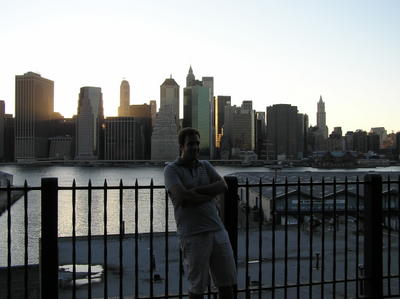 Brooklyn offers some spectacular views of NYC, and we had dinner while watching slowly the sunlight vanishing and the lights turning on in the buildings. The final night view was beautiful, just beautiful...
Brooklyn offers some spectacular views of NYC, and we had dinner while watching slowly the sunlight vanishing and the lights turning on in the buildings. The final night view was beautiful, just beautiful...
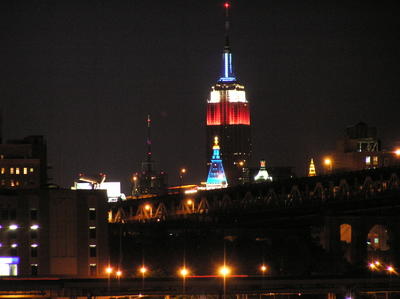 This is the Empire state building, all the way from Brooklyn with 10x zoom. Damn, I love this camera!
This is the Empire state building, all the way from Brooklyn with 10x zoom. Damn, I love this camera!
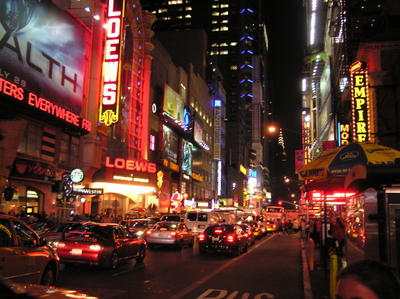 The busy 42nd street, home of cinemas, theatrical plays and shows is always busy at night. The Chrysler Tower can be seen in the background.
The busy 42nd street, home of cinemas, theatrical plays and shows is always busy at night. The Chrysler Tower can be seen in the background.
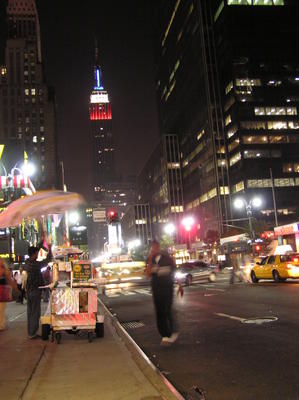 I will have to end this with a picture that captures so much of NYC by night; I just love it. The food stand, people walking fast, traffic lights, cabs, lights, skyscrapers, plus the Empire State in the background. Goodnight, New York. Goodnight...
I will have to end this with a picture that captures so much of NYC by night; I just love it. The food stand, people walking fast, traffic lights, cabs, lights, skyscrapers, plus the Empire State in the background. Goodnight, New York. Goodnight...
 As I was walking in front of the public library in the morning on our way to the subway, I noticed a familiar face across the street. What are the chances that you and one of your close friends will happen to meet eachother by complete accident in the middle of Manhattan at a random day of the year? I didn't know he was there, nor did he that I was. We have barely met eachother inside the usc campus, not in another city!
As I was walking in front of the public library in the morning on our way to the subway, I noticed a familiar face across the street. What are the chances that you and one of your close friends will happen to meet eachother by complete accident in the middle of Manhattan at a random day of the year? I didn't know he was there, nor did he that I was. We have barely met eachother inside the usc campus, not in another city! First stop was the Guggenheim museum, a building with a great architecture that nevertheless reminds a toilet from the outside. We were lucky to be the only 2 people in the 11am tour, so a cute asian-american girl showed us around privately, and that was so great since we could discuss freely wondering what the hell were we seeing. Guggenheim is an art museum (paintings, some picassos, sculptures, everything after 1800's). She was a volunteer then and also very kind of explaining the story and makings of several paintings. Thanks!
First stop was the Guggenheim museum, a building with a great architecture that nevertheless reminds a toilet from the outside. We were lucky to be the only 2 people in the 11am tour, so a cute asian-american girl showed us around privately, and that was so great since we could discuss freely wondering what the hell were we seeing. Guggenheim is an art museum (paintings, some picassos, sculptures, everything after 1800's). She was a volunteer then and also very kind of explaining the story and makings of several paintings. Thanks! Straight opposite from the museum, we entered central park, and after only 2 minutes of walking we found ourselves in the place above that hardly reminds of a metropolitan city. We met a lady at starbucks that she and her husband just retired, and they decided to spend the rest of their lives in Manhattan. As she very well put it, NYC wouldn't be the same without Central Park. So true.
Straight opposite from the museum, we entered central park, and after only 2 minutes of walking we found ourselves in the place above that hardly reminds of a metropolitan city. We met a lady at starbucks that she and her husband just retired, and they decided to spend the rest of their lives in Manhattan. As she very well put it, NYC wouldn't be the same without Central Park. So true. Thousands of people had flocked in Central Park at this beautiful Saturday afternoon. The oval garden dominates the center, where people play baseball, soccer, roller-skate, have picnics or just lie down under some shadow.
Thousands of people had flocked in Central Park at this beautiful Saturday afternoon. The oval garden dominates the center, where people play baseball, soccer, roller-skate, have picnics or just lie down under some shadow.
Meanwhile, at the Southeast corner a set of truly excellent performers were announcing joking "We need money for college. Give us yours so that we don't have to go". They were also plain true: "The more money you give us the more we stay outside your home". Really good show.
 I think this is my favorite building in New York. The colorful skyscraper opposite of the Bus Terminal just made my day, every day I walked by it.
I think this is my favorite building in New York. The colorful skyscraper opposite of the Bus Terminal just made my day, every day I walked by it. Towards the evening we decided to do The Walk: Walk across the Brooklyn Bridge, the very first bridge built 130 years ago that connected the island of Manhattan with the mainland (Brooklyn). Hundreds of people and bicyclists were walking at the time.
Towards the evening we decided to do The Walk: Walk across the Brooklyn Bridge, the very first bridge built 130 years ago that connected the island of Manhattan with the mainland (Brooklyn). Hundreds of people and bicyclists were walking at the time. Brooklyn offers some spectacular views of NYC, and we had dinner while watching slowly the sunlight vanishing and the lights turning on in the buildings. The final night view was beautiful, just beautiful...
Brooklyn offers some spectacular views of NYC, and we had dinner while watching slowly the sunlight vanishing and the lights turning on in the buildings. The final night view was beautiful, just beautiful... This is the Empire state building, all the way from Brooklyn with 10x zoom. Damn, I love this camera!
This is the Empire state building, all the way from Brooklyn with 10x zoom. Damn, I love this camera! The busy 42nd street, home of cinemas, theatrical plays and shows is always busy at night. The Chrysler Tower can be seen in the background.
The busy 42nd street, home of cinemas, theatrical plays and shows is always busy at night. The Chrysler Tower can be seen in the background. I will have to end this with a picture that captures so much of NYC by night; I just love it. The food stand, people walking fast, traffic lights, cabs, lights, skyscrapers, plus the Empire State in the background. Goodnight, New York. Goodnight...
I will have to end this with a picture that captures so much of NYC by night; I just love it. The food stand, people walking fast, traffic lights, cabs, lights, skyscrapers, plus the Empire State in the background. Goodnight, New York. Goodnight...
Thursday, July 07, 2005
Laetitia
Wednesday, July 06, 2005
Natural History Museum - NYC
That was probably the best museum of its kind that I've ever been - most definately I had the greatest fun for sure there. Even if you exclude the astonishing Planetarium, their collection is quite amazing.

This is the largest meteorite rock on display in any museum in the world - a huge chunk of iron that travelled billions of miles through space to set here and be touched be a Greek guy in 2005.

My weight on Jupiter (not actually the weight, since the mass is the same anywhere; they mean the gravitational force).

Oups! I found one for the Sun too...
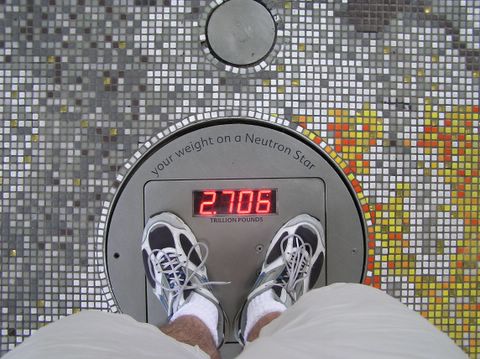
2.7 trillion pounds around a typical Neutron star... the earth would fit in a tea spoon if it was as dense as these guys are.
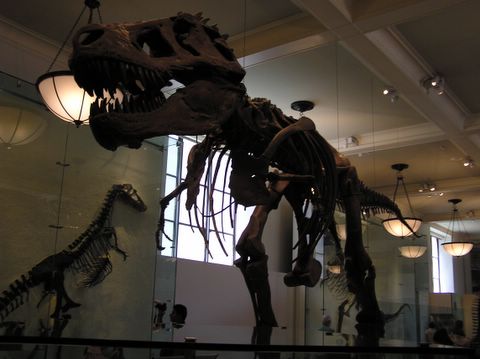
Mr. T-Rex is watching... they have the largest dinosaur collection I've ever seen anywhere in the world.
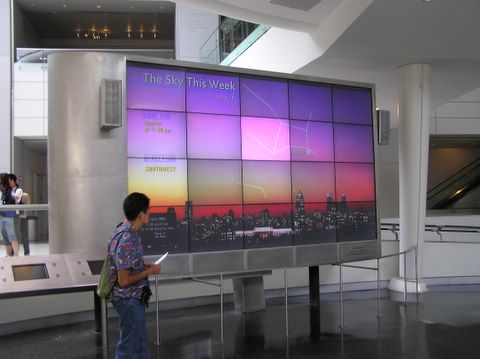
Plus the daily news on what to watch in the night sky; if you go several miles outside NYC of course since almost nothing is visible over Manhattan - not to mention setting up a telescope in Times Square.
Plus, they have lots of bones, skulls and skeletons of the first humans - Cro Manions, Neadertals etc. Animals and birds that date back 300,000,000 years into the history of the planet. We only spent with Bing 3 hours total, but next time I will be better prepared.

This is the largest meteorite rock on display in any museum in the world - a huge chunk of iron that travelled billions of miles through space to set here and be touched be a Greek guy in 2005.

My weight on Jupiter (not actually the weight, since the mass is the same anywhere; they mean the gravitational force).

Oups! I found one for the Sun too...

2.7 trillion pounds around a typical Neutron star... the earth would fit in a tea spoon if it was as dense as these guys are.

Mr. T-Rex is watching... they have the largest dinosaur collection I've ever seen anywhere in the world.

Plus the daily news on what to watch in the night sky; if you go several miles outside NYC of course since almost nothing is visible over Manhattan - not to mention setting up a telescope in Times Square.
Plus, they have lots of bones, skulls and skeletons of the first humans - Cro Manions, Neadertals etc. Animals and birds that date back 300,000,000 years into the history of the planet. We only spent with Bing 3 hours total, but next time I will be better prepared.
Tuesday, July 05, 2005
Back to school
Monday, July 04, 2005
Crab blog
I've had so much input the last 2 weeks that I could easily write a book about them. However I'll just narrow it down to a few photos and comments, and I will do that in a backwards manner, starting from the most recent events and then going back into the past.
I will start with the most impressive virtual reality presentation I've ever seen: The Hayden Planetarium.
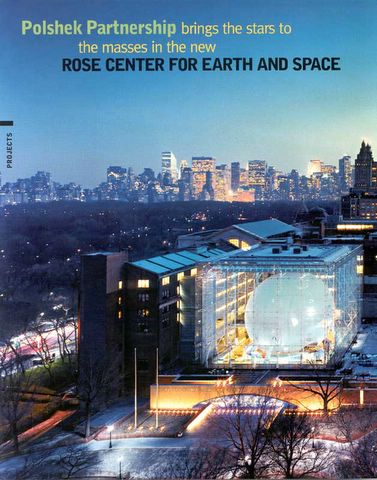
It is part of the Natural History Museum in New York, and it is truly a work of art. In its core lies a space dome that is light years ahead of anything I've seen before.

In its core lies the most perfect Planetarium Projector in the world: Zeiss Mark IX.
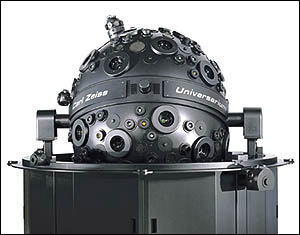
This guy produces pictures of the night sky far better than most people in the world can see (due to light pollution). Stars, nebulas, planets, galaxies are just for starters. The stars have natural variations in their brightness (as in reality). Several objects in the sky require binoculars in order to be seen, just as in the real sky. The colors are most accurate. But the most important feature is that the projector's brightness allows someone to superimpose video at the surface of the dome without the starry sky being lost in the background. And this is where the fun starts.
As you sit down inside the dome, there are some faint purple lights; the show starts; the lights go down; for a few seconds there is darkness; then lights from the outer shell of the dome start spinning, revealing some of the structure behind the dome screen such as speakers and bars; the voice of Tom Hanks announces the projector as it rises slowly in the center of the dome; the lights go off; a magnificent picture of the night sky appears on the dome, which looks impossibly real; as the sky rotates, the constellations start appearing in the sky; the constellations become mythical figures; the figures become astronomical charts; the ecliptic is added; and before you realize it the sun has appeared and the trajectories of the inner planets of the solar system are drawn, as the camera moves through them at faster-than-light speeds.
It is a shame to try to describe the 3D feeling that the projection masterfully achieves. I think I wow-ed at least 10 times during the show, which overshadows all my previous wow experiences I have had. And this is all thanks to Bing's boyfriend's friend who kept insisting the night before to visit the Dome. 1000 thanks, dude!
I will start with the most impressive virtual reality presentation I've ever seen: The Hayden Planetarium.

It is part of the Natural History Museum in New York, and it is truly a work of art. In its core lies a space dome that is light years ahead of anything I've seen before.

In its core lies the most perfect Planetarium Projector in the world: Zeiss Mark IX.

This guy produces pictures of the night sky far better than most people in the world can see (due to light pollution). Stars, nebulas, planets, galaxies are just for starters. The stars have natural variations in their brightness (as in reality). Several objects in the sky require binoculars in order to be seen, just as in the real sky. The colors are most accurate. But the most important feature is that the projector's brightness allows someone to superimpose video at the surface of the dome without the starry sky being lost in the background. And this is where the fun starts.
As you sit down inside the dome, there are some faint purple lights; the show starts; the lights go down; for a few seconds there is darkness; then lights from the outer shell of the dome start spinning, revealing some of the structure behind the dome screen such as speakers and bars; the voice of Tom Hanks announces the projector as it rises slowly in the center of the dome; the lights go off; a magnificent picture of the night sky appears on the dome, which looks impossibly real; as the sky rotates, the constellations start appearing in the sky; the constellations become mythical figures; the figures become astronomical charts; the ecliptic is added; and before you realize it the sun has appeared and the trajectories of the inner planets of the solar system are drawn, as the camera moves through them at faster-than-light speeds.
It is a shame to try to describe the 3D feeling that the projection masterfully achieves. I think I wow-ed at least 10 times during the show, which overshadows all my previous wow experiences I have had. And this is all thanks to Bing's boyfriend's friend who kept insisting the night before to visit the Dome. 1000 thanks, dude!
9,500
That is the number of mp3 songs in my hard drive as of now, after recent additions from Alex Dimakis, Yiouk, and some other sources. That is 50GB of data, and I need 1 month of 24/7 listening to listen to all of them.
Friday, July 01, 2005
Exam is over!
My god, that was SO overwhelming. The whole trip here was worth it for the last day only. The breakfast, the games in class, Waldo, the soccer, the dinner, the exam, the exam, the exam, Charle's hangover, and all the pics and videos. Karen, Diktys, Mike, Matt, Rodrigo, Charles, that was one hell of a fellowship. After finishing the exam at 11pm, we stayed until now (3am?) to discuss, drink beers, exchange msn numbers ( I added a new group: South America!), emails, and pics. The most useful thing in my new laptop is the memory card slot, which accepts all types. So I just got all the sticks from everyone's camera, and burned all the pics into cds for everyone, which we all signed afterwards, hoping that we might be able to keep forever what we had at that last night and for the past 2 weeks.
I will be heading for NYC tomorrow for the 3rd time within the last year, which I think might turn out to be somewhat dull after all this we went through. Here is our tribute to the great Waldo:
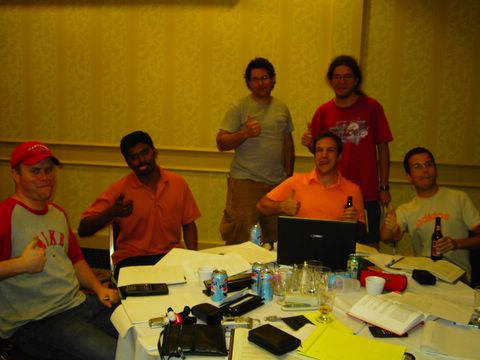
Karen: You are one of the greatest girls I have ever met
Diktys: Θα τα ξαναπούμε πολύ σύντομα
Mike: Keep Charles in good mood all the time
Matt: Hail to the King of Malaka
Rodrigo: You need to sleep :-)
Charles: See you at the us open
Jeff & the rest: No more beers!
I hope I'll see everyone again somehow, sometime, somewhere.
I will be heading for NYC tomorrow for the 3rd time within the last year, which I think might turn out to be somewhat dull after all this we went through. Here is our tribute to the great Waldo:

Karen: You are one of the greatest girls I have ever met
Diktys: Θα τα ξαναπούμε πολύ σύντομα
Mike: Keep Charles in good mood all the time
Matt: Hail to the King of Malaka
Rodrigo: You need to sleep :-)
Charles: See you at the us open
Jeff & the rest: No more beers!
I hope I'll see everyone again somehow, sometime, somewhere.
Subscribe to:
Posts (Atom)
Categories
- Apple (41)
- Art (2)
- Astronomy (2)
- Books (1)
- Conferences (35)
- cool (30)
- Explanations (1)
- Favorites (39)
- Flight Blogs (8)
- food (4)
- geeky (71)
- Greece (19)
- greeks (20)
- hdr (6)
- hdr london (1)
- internet (2)
- iPhone (3)
- kids (2)
- Las Vegas (11)
- life (143)
- London (22)
- Los Angeles (40)
- Lost (37)
- matlab (1)
- Maui (5)
- Miami and The Bahamas (11)
- Movies (109)
- nature (1)
- New York (39)
- New York Guide (10)
- phd (14)
- Photography (2)
- Physics (1)
- Plasma Road Trip (10)
- Podcast (6)
- science (39)
- shows (17)
- TED (4)
- trips (102)
- United Kingdom (5)
- USA (7)
- usc (3)
- Vista (9)
- weather (1)
- wedding (3)
- ΕΜΠ (1)





